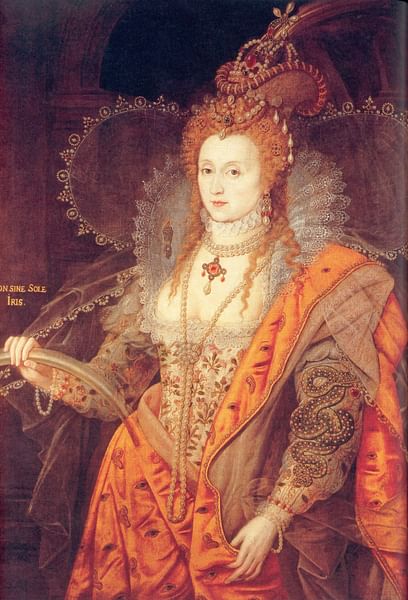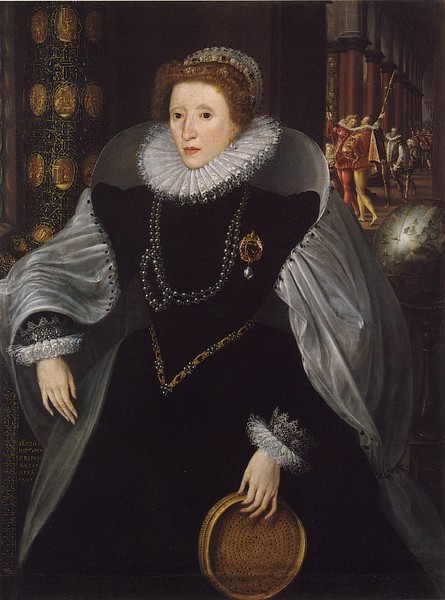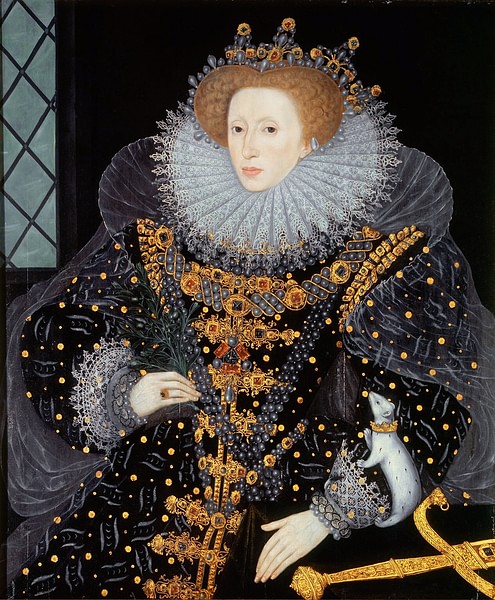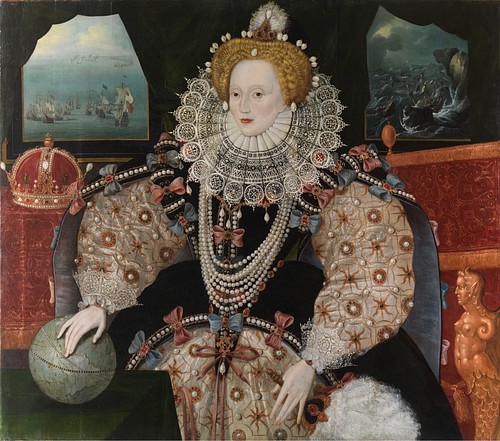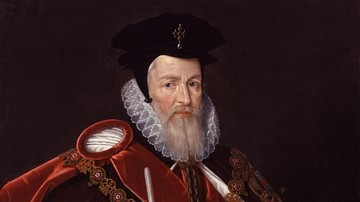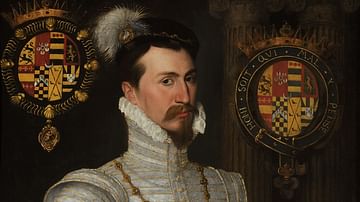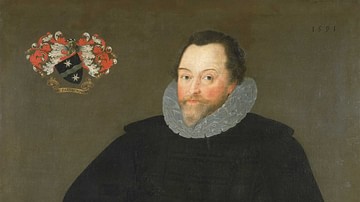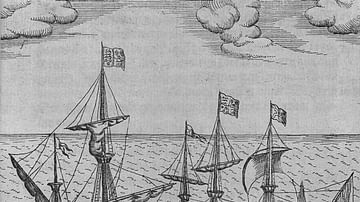Aware of the power of appearances, Elizabeth I of England (r. 1558-1603 CE) carefully controlled her image throughout her reign and through costume, hair, jewellery, and art, she presented herself as the great Virgin Queen. Like a goddess of antiquity, Elizabeth announced that she had sacrificed her own personal inclinations to rule for the good of her people. The cult of the queen was further fuelled by the literature of the period, and for those who could not witness the marvellous spectacle of the queen's great dresses, jewels, and wigs, there were official royal portraits which were packed with symbolic meaning. Elizabeth I is still venerated today as one of the great rulers of English history, and this is thanks not only to her achievements as a monarch but also to the memorable invention of herself as a legend in her own lifetime.
The Virgin Queen
In 1558 CE Elizabeth I inherited a fragile kingdom divided within by religious beliefs and surrounded by enemies abroad. All territory in France had now been lost, the state was almost bankrupt, and politics was still very much a male-dominated arena where a queen was expected to marry as soon as possible. Consequently, Elizabeth had to tread carefully and, refusing to marry, she instead cultivated an image of herself as the Virgin Queen. Elizabeth was married only to her kingdom, she said, and so was able to concentrate on the good of all her people. This became the central message of the queen's iconography and was put into words in her reply to Parliament's move to have her marry in 1559 CE:
Nothing, no worldy thing under the sun, is so dear to me as the love and goodwill of my subjects. In the end this shall be for me sufficient, that a marble stone shall declare that a queen, having reigned such a time, lived and died a virgin.
(Phillips, 116)
Whether the queen was still a virgin or not mattered little; officially, at least, she remained chaste. Like the great goddesses of antiquity Athena/Minerva and Artemis/Diana or the Lady of Arthurian chivalric literature who attracted courtly love, she would remain apart from and above all men. Indeed, Elizabeth's carefully controlled public image began with the veneration of the queen herself as a semi-divine figure. Elizabeth's date of succession, 17 November, was declared a national holiday and was celebrated each year with great festivities, church services, and bell-ringing. Further, Elizabeth, who continued the English Reformation begun by her father Henry VIII of England (r. 1509-1547 CE) and elder half-brother Edward VI of England (r. 1547-1553 CE), became the living embodiment of the Virgin Mary, the ultimate Defender of the Faith monarch. The Bishop's Bible, printed from 1569 CE gave another opportunity to reinforce the link. The frontispiece showed Elizabeth being crowned by the four virtues of Fortitude, Justice, Mercy, and Prudence. Another avenue to reach a wide audience was to have paintings celebrating the queen's success over the Spanish Armada (see below) hung in churches now largely stripped of their Catholic adornments. The queen's image appeared not only in paintings (from life-size works to miniatures) but also woodcut prints, engravings, coins, medals, badges, and jewelled brooches. Miniatures of Elizabeth became almost like religious icons and were worn on noble chests of both sexes to show support and deference to their great queen.

Thanks to favourable literature, Elizabeth became known as the great empress 'Gloriana', after the central figure of the 1590 CE poem The Fairie Queen by Edmund Spenser (c. 1552-1599 CE). Another cultivated association was that Elizabeth was Astraea, the virgin of the Eclogues by the Roman writer Virgil (70-19 BCE). Astraea returned to earth and with her brought in a new Golden Age where there was eternal peace, just as Elizabeth's reign was presented. Beyond literature, one court spectacle in 1581 CE depicted the queen as the 'Fortress of Perfect Beauty' successfully withstanding a siege by a cannon representing 'Desire' but which could only fire sweets at its target. Walter Raleigh named a portion of North America, England's first overseas colony after his queen: Virginia (Roanoke Island, modern North Carolina). The Elizabethan imagery and propaganda was relentless.
Public Appearances & Show
Another facet of the queen's image was her public appearances. The queen started to wow her public immediately at her coronation in Westminster Abbey on 15 January 1559 CE, one of the most sumptuous and expensive ceremonies ever seen. The great ceremony itself was preceded by a round of speeches, processions and pageants. For the big day, Elizabeth wore custom-made robes of velvet with ermine fur and trimmings of embroidered gold thread and pearls. Not only did she wow her court, government, and visiting dignitaries with her appearance wearing breathtaking dresses, ruffs, and hairpieces but she took care to appear before commoners, too. No English monarch ever toured their kingdom so frequently and showed themselves to so many of their people as Elizabeth did. The queen conducted at least 25 annual tours to various country residences of her nobles, usually travelling in great style with a vast entourage of courtiers, servants, 300 wagons, and 2,000 horses. Locals were often treated to free displays of pageantry and fireworks. There were, too, regular medieval tournaments at Greenwich, Hampton Court, and Whitehall, where knights jousted to win the queen's favour. Elizabeth even tried to convince the public she was physically more robust than she actually was by frequently riding, hunting, and dancing at court.
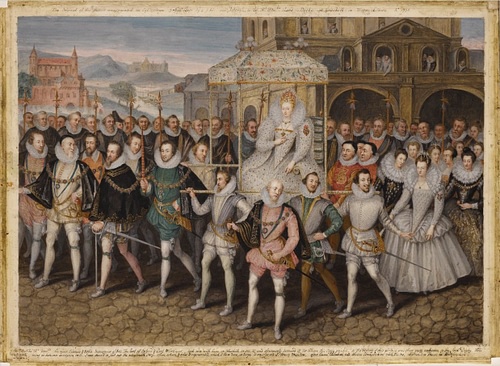
The queen wore a striking array of wigs, unfortunately, necessitated by an attack of smallpox in December 1562 CE which had left her with bald patches. The disease had also left Elizabeth with facial scars, which explains her use of thick white makeup. The ravages of the disease and the passage of time perhaps also explain why the queen insisted her residences have no mirrors. Even during wartime, Elizabeth could not resist the opportunity of a memorable public appearance. When the Spanish Armada attacked England in the summer of 1588 CE, the queen visited her land army awaiting the invaders at Tilbury. Elizabeth appeared resplendent wearing shining armour on her torso and riding a grey gelding. She then gave a rousing speech that victory would belong to England.
The Royal Portraits
As few would ever see their queen in person, portraits were an especially powerful way of communicating the message of Elizabeth's right to rule and her success at it. Portraits were regularly commissioned using celebrated artists, although they often show the idealised 'Mask of Youth' of the queen, even if some do show a slight ageing of their subject as she went through her 44-year reign. The miniaturist specialist Nicholas Hilliard (1547-1619 CE) was the Peter Carl Fabergé of the period and he produced officially-approved idealised portraits, albeit exquisitely rendered in gold and other precious materials like the famous Armada Jewel. The queen's larger portraits copied this idealised approach, but they have the additional interest of being packed full of meaning and symbolic imagery. So carefully orchestrated was this build-up of the flattering royal portrait album that from 1563 CE, Elizabeth even banned the production of unofficial portraits of the royal person. Below is an examination of just some of the most famous of Elizabeth's portraits painted during her lifetime.
The Pelican Portrait
The Pelican Portrait, so-called because of a pelican brooch the queen wears, was painted around 1574 CE by Nicholas Hilliard. The queen is wearing a red and cream dress studded with pearls and square-cut jewels. The pelican brooch hangs at the centre of Elizabeth's chest with its wings spread wide. The bird was a symbol of redemption and charity as a mother pelican was said, in times of strife, to pierce her own chest to feed her young from her own blood. Above the queen, on the left, is the Tudor Rose and on the right the fleur-de-lis, symbol of England's ongoing claim to the French throne. Above both of these symbols is an arched imperial crown. The Pelican Portrait now resides in the Walker Art Gallery, Liverpool, England.
The Sieve Portrait
The Sieve Portrait, so-called because the queen holds a large sieve in her left hand, was painted between 1579 and 1583 CE by the Flemish artist Quentin Metsys the Younger. There are, like many of the queen's portraits, other versions of this painting, and the sieve, symbol of chastity, identifies Elizabeth in the role of Tuccia from Roman mythology. Tuccia was a Vestal Virgin who demonstrated her chastity by carrying water from the Tiber River to her temple only using a sieve. Elizabeth wears an unusually plain black dress with white lace trim (both colours being symbolic of purity and constancy) and a necklace of black pearls with an impressive brooch. The left of the painting shows a column decorated with scenes from the Aeneas and Dido story of Roman mythology. Aeneas abandoned the Queen of Carthage and so chose power over personal happiness. The story is, then, a fitting one for a portrait of the Virgin Queen who shunned marriage and became Mistress of her kingdom. Behind Elizabeth on the right of the painting is a globe on which sail English ships, symbolic of the queen's imperial power. The men in the background are courtiers, one of whom is the queen's favourite of the period, Sir Christopher Hatton, shown in the centre. The painting now resides in the Pinacoteca Nazionale, Sienna, Italy.
The Ermine Portrait
The Ermine Portrait, so-called because of the presence of that animal on the queen's left lower arm, was painted around 1585 CE. It has been attributed by some scholars to William Segar. Resplendent in a sumptuous black dress with gold trimmings and jewels, she is wearing a triple string of black pearls. The queen has a gold sword, perhaps the sword of state and representing justice, on a small table within easy reach of her left hand. The ermine climbing onto the queen's arm was a symbol of purity and royalty, and here the animal even wears a gold crown around its neck. Elizabeth holds an olive branch, a traditional symbol of peace, in her right hand. The Ermine Portrait now resides at Hatfield House, Hertfordshire, England.
The Armada Portrait
The Armada Portrait, so-called because the windows behind the queen look out to the sea battle against the Spanish Armada, was painted around 1588 CE, shortly after the Armada was defeated. It is attributed to George Gower, although various versions exist. The queen wears a black and silver-cream dress with billowing sleeves studded with pearls and a black cloak. Elizabeth is also wearing a necklace with eight strings of pearls, there are pearls hanging from her torso and yet more pearls arranged in her hair. Looking youthful for her 57 years, the queen holds the handle of a fan in her left hand while her right is placed over a globe to symbolise England's burgeoning ambitions for empire-building. Appropriately enough, the queen has her hand over North America, the location of England's first colony Virginia. On the left is the Tudor imperial crown and at the far right in the foreground is a golden statue of a mermaid. Behind the queen, the window on the left shows the two naval fleets about to engage while the window on the right shows the Spanish being battered by storms and wrecked against a rocky shore. The most famous version of the Armada Portrait now resides in the Royal Museums Greenwich, England.
The Rainbow Portrait
The Rainbow Portrait (see title image), so-called because the queen grasps a rainbow in her right hand, was painted towards the end of Elizabeth's reign, between 1600 and 1602 CE. It has been attributed to Isaac Oliver or Marcus Gheeraerts the Younger or Taddeo Zuccari. The queen wears a cream dress embroidered with wildflowers and dripping in pearls. On the queen's left lower arm is a snake, symbol of wisdom, with a heart-shaped ruby pendant hanging from its mouth. The bright orange lining of her cloak is curiously covered in eyes and ears, symbolic that the queen was ever-vigilant in looking out for the best interest of her subjects. Above the rainbow, a symbol of peace, there is an inscription which reads Non sine sole iris or 'No rainbow without the sun' with the message being the queen's wise rule is as important as the sun to the prosperity of her kingdom. The Rainbow Portrait also now resides at Hatfield House in Hertfordshire.
